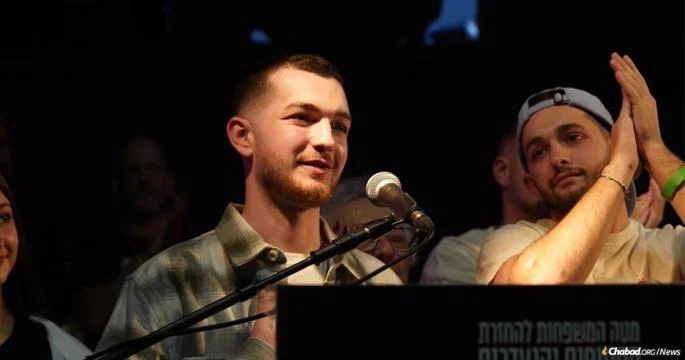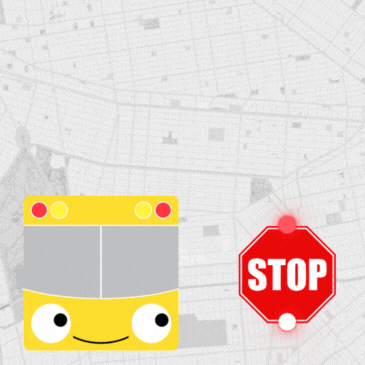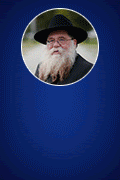
The Hostage’s Tefillin Wrapped Round the World
by Yehudis Litvak – chabad.org
On Tuesday night, speaking for the first time at Hostages Square in Tel Aviv, recently released hostage Bar Kupershtein extended a moving invitation to the gathered:
“I want to invite everyone this Friday, at 10 o’clock in the morning. I want to organize a mass tefillin laying, where you all put them on together with me. Fulfill my dream with me! My dream was to lay tefillin in captivity. And we’ll do it for the freedom of our brothers still held captive.”
With this invitation, Bar is expanding the tefillin initiative begun by his mother, Julie Kupershtein, while he was held captive by terrorists in Gaza. Throughout the two-year-long ordeal, Julie has been inspiring people worldwide with her steadfast faith and urging Jewish men to lay tefillin in the merit of Bar and other hostages.
Always in the Hands of the Creator of the World
Julie did not choose the spotlight. She is naturally a private person, busy with taking care of her disabled husband, a paramedic who was injured in a car accident, and her five children. When her son Bar was kidnapped by Palestinians on Oct. 7, 2023, she chose not to get involved in politics or the media. Instead, she threw herself into prayers and good deeds in his merit.
As a result of this decision, Julie received a shocking phone call. Speaking in a heavily accented Hebrew, the caller identified himself as a Hamas terrorist holding her son. The terrorist said, “You families of hostages have a lot of power, but you are not doing anything!”
Julie objected, “You don’t know what I do or don’t do. I pray, and I do things that create merits for Bar and other hostages.”
The terrorist threatened that if she wanted to see her son ever again, she must get involved in protesting, criticizing Israel internationally and attempting to topple the Israeli government.
Julie replied, “I am not afraid of you! And my Bar is not in your hands. He is in the hands of the Creator of the World. And you, too, are in the hands of the Creator of the World.”
There was a brief silence on the line, and then the terrorist responded, “Well done, madam!”
Bar’s Tefillin
The conversation with the terrorist strengthened Julie’s faith. She continued to stay away from politics and publicity, intensifying her efforts to bring more mitzvah opportunities to Jews world over.
One of Julie’s requests to her fellow Jews was that Bar’s tefillin remain in continuous use while Bar was unable to use them himself.
In today’s age of social media, Julie’s request instantly spread and received a tremendous response. Julie chose to entrust the tefillin to Tzvika Graiver, an attorney and entrepreneur from Bat Yam, just south of Tel Aviv.
Graiver did not have a personal connection with the Kupershtein family. However, shortly before he heard about Julie’s request, he embarked on his own tefillin initiative, putting up a tefillin stand on the beach near his home, where he used his own pair to encourage others to do the mitzvah. “I put on tefillin every day,” Graiver says. “That’s one of my favorite things to do.” He wanted to share the mitzvah with other Jews and found that people appreciated the opportunity.

When Graiver offered to use Bar’s tefillin for his stand, which he even took with him on his business travels, Julie Kupershtein accepted the offer. Starting in May 2024, Bar’s tefillin embarked on a journey. The entire Graiver family got involved, including his young daughters, who prayed for Bar every day and asked for Bar to come back for their birthday present.
Graiver would set up a small desk with Bar’s picture on it and tell people about Bar’s heroism on Oct. 7. As a security guard, Bar could have escaped the Nova site. Instead, he chose to stay and use his paramedic training to treat the wounded and save lives.
One of the most poignant moments for Graiver was an encounter on the beach in his hometown of Bat Yam. Graiver offered a young passerby to put on tefillin. At first, the young man wasn’t interested, but when Graiver explained that it belonged to a hostage who was captured at the Nova festival while trying to save lives, the young man agreed.
“I wrapped it on him,” recalls Graiver. “He didn’t know how to do it. He took a tallit, put it on his head and faced the sea.” The young man spent a long time praying. When he finished, he told Graiver that he himself was a Nova survivor.
Another encounter was with two young men who knew Bar from the army. They got very emotional when they put on the tefillin. Graiver, who had never met Bar in person, was moved by the stories the two young men told about him—how Bar would always be the first to volunteer and help whenever there was a need.
When Graiver was himself called up to the army as a reservist, he took Bar’s tefillin with him and gave his fellow reservists opportunities to don them. Graiver’s experience in Gaza strengthened his dedication to the tefillin initiative. “I saw the tunnels, and I knew that the only way Bar was going to come back would be with G‑d’s help and the prayers of the Jewish people,” he says.
Around the world
When Graiver traveled to the United States, Canada, Mexico and Greece on business, he contacted the local Chabad rabbis, who immediately volunteered to help. While Graiver was busy with his work, Chabad rabbis “had my back,” he says. “I knew that the tefillin were in the best hands they could be.”
In Miami, a local Chabad rabbi, with the family’s permission, passed the pair of tefillin all around Florida, with other Chabad rabbis driving for hours to pick it up and return it. The Kupershtein family was happy to see the initiative spreading far and wide with Chabad’s involvement.
When Rabbi Mendy Kaminker of Chabad of Hackensack, N.J., heard about the initiative, he was determined to bring Bar’s tefillin to his community. He made a special effort to travel to La Guardia Airport to pick up the tefillin from Rabbi Yehuda Teichtal of Berlin, who had a few-hour layover at the airport.
Both rabbis filmed an emotional video of the tefillin transfer. “This is very special, very unique, and the entire world is involved in this!” said Rabbi Teichtal.

Rabbi Kaminker posted on social media, inviting people to lay Bar’s tefillin. The response was incredible, he says. “People were crying and praying for the hostages. Everyone wanted to give Bar a hug, but because they couldn’t, they performed a mitzvah that was like a hug. When you hold a holy object that belongs to a hostage, it’s a whole new level of connection. The power of a mitzvah removes all barriers, all physical limitations.”
Jews from all walks of life used the opportunity to lay Bar’s tefillin. Some of them lay it regularly, while others hadn’t done so in decades. A teenage boy put on tefillin for the first time in his life. He was very happy to do something for the hostages.
Chabad of Hackensack’s staff created a video for the Kupershtein family, in which Jews wearing Bar’s tefillin conveyed their prayers and support. An older man with tears in his eyes said, “I’m so honored to be putting it on today for Bar. May he have strength, may you have strength, and may he come home very soon!” A middle-aged woman standing next to her husband, who was wearing Bar’s tefillin, said, “I just want you to know that we have Bar’s picture on our door. We are thinking of him, we are praying for him, and he should only come home healthy and safe very soon!”
When Tzvika Graiver traveled to Georgia, he contacted Rabbi Mendy Gurary of Chabad Israeli Center in Atlanta, who was excited to bring this opportunity to every Chabad House in the state.
Chabad Israeli Center created a beautiful poster with a picture of Bar in a military uniform with his tefillin on. Rabbi Gurary arranged a spreadsheet where rabbis could sign up for a time slot with Bar’s tefillin. Georgia’s Chabad rabbis responded with much enthusiasm, and hundreds of Jews in Georgia had the opportunity to lay Bar’s tefillin.
Chabad Israeli Center hosted a beautiful event, where the attendees took turns laying Bar’s tefillin and participated in prayers for the hostages. “Most of our community is Israelis,” says Rabbi Gurary. “For them to put a hostage’s tefillin on and feel like they’re doing something for the hostages while they’re living in America, and making an impact on their return was very, very powerful.”
Rabbi Gurary describes the excitement he witnessed as people put on Bar’s tefillin akin to that of a bar mitzvah boy laying tefillin for the first time ever. Many of them had not laid tefillin in years. “They really felt like they were holding something holy, something that connects them to the pain and to the hope that [the hostages] would come out because of it,” says Rabbi Gurary.
Rabbi Mendy Wineberg of Chabad of Dunwoody, Georgia, brought Bar’s tefillin to his community for one morning. One of his congregants, Ethan Davidson, described it as “a magical tefillin experience. … The gravity of the moment was heavy, and I felt so connected.”
“It was very real,” says Rabbi Wineberg. “People internalized the idea that they were doing a mitzvah on behalf of Bar, who couldn’t. Living far away and not being able to make a real impact, the opportunity to do something positive and make it a source of inspiration for people was very moving. It brought it closer to home and honed in the feeling that we are all one people who care for each other.”
Rabbi Dovid Goldschmidt, who heads the CTeen program in Atlanta, brought Bar’s tefillin to a pluralistic Jewish high school. Many boys lined up to put it on. Rabbi Goldschmidt says, “It could seem very far away, what’s happening in Israel and Gaza, but this really brought it actually home, and the boys were very clearly moved to be able to wrap this tefillin.”
Rabbi Goldschmidt reflects that Bar is not that much older than those teen boys, which made the experience all the more meaningful for them. He adds that it’s not easy being a Jewish teenager today. “Especially with teens being on social media, there’s a lot of negativity and hate and just pessimism. It’s very depressing. [Bar’s tefillin] really just gave them a lot of hope, it gave them a lot of courage and strength, and it brought a smile to their faces.”

Campaign: Tefillin for Every Hostage
As the Kupershtein family watched the impact of Bar’s tefillin on world Jewry, they decided to expand the initiative, encouraging Jewish men who do not regularly lay tefillin to commit to putting it on every day in the merit of their son or another hostage.
The campaign, called Tefillin for Every Hostage, aimed to ensure that for every hostage held in Gaza, there would be another Jew in the world laying tefillin daily for as long as the hostage is unable to do so. Donors stepped up to provide tefillin for the volunteers. The initiative spread far and wide, with tefillin stands with hostages’ pictures popping up all over Israel.
Last June, Israel’s President Isaac Herzog hosted an emotional gathering in support of the Tefillin for Every Hostage campaign. The gathering was attended by the Kupershtein family and other hostage families.
At the event, Herzog said: “I wish for all of us to continue doing everything possible to bring everyone home—all of them, down to the last one. Let us cry out, demand, insist, tear open the gates of Heaven, and bring them home. … I put on tefillin every day. We are all praying for their return, and I am confident that our prayers will be answered.”
The prayers and well wishes coming from all over the world were fulfilled this past Sukkot, when Bar was released together with the other living hostages. Videos of his tearful reunion with his family evoked emotional responses all over the world.
Those who had an opportunity to lay Bar’s tefillin felt especially elated. Rabbi Gurary says, “When we announced Bar’s release in our community, it gave people a feeling that by doing something good, by doing a mitzvah, you could change the world.”
For Tzvika Graiver, seeing Bar come home was the most satisfying experience of his life. The Graiver family went to visit him. “It was like meeting our son, our brother, a beautiful and exciting moment,” says Graiver. His 4-year-old daughter was the first to recognize Bar from the picture on the tefillin stands. Graiver returned Bar’s tefillin to him in another emotional reunion.
Graiver feels grateful to G‑d for his role in Bar’s story. “I feel that I was chosen for a very important mission,” he says. “The Jewish people came together for this [initiative], and by doing that, they managed to bring Bar home. It shows that if the Jewish people want something and we gather together, nothing can stop us.”













